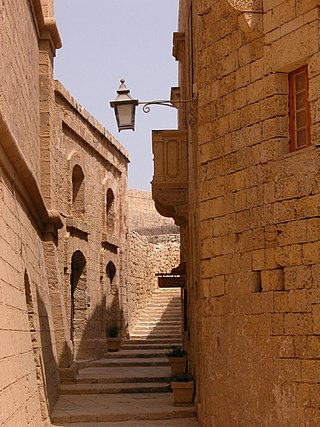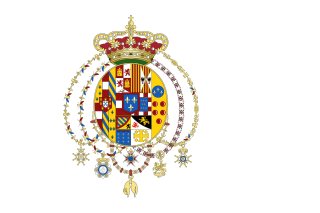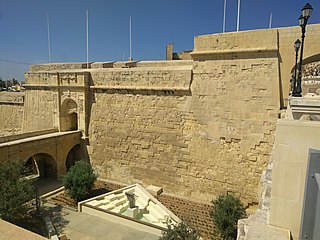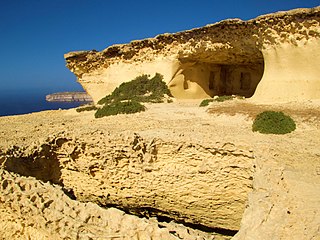
Victoria, also known among the native Maltese as Rabat or by its title Città Victoria, is an administrative unit of Malta, and the main town on Gozo. Victoria has a total population of 6,901, and is the most populous settlement in Gozo.

Żebbuġ is a village and an administrative unit of Malta, in the northwest coast of the island of Gozo. It is located close to Għarb and Għasri and is built on two hilltop plateaus, Ta' Abram and Ix-Xagħra taż-Żebbuġ. The fishing port and tourist resort of Marsalforn lies within the Żebbuġ Council. The village has a population of 2,956, which makes it the fifth largest in Gozo, after Xewkija.

Fort St. Angelo is a bastioned fort in Birgu, Malta, located at the centre of the Grand Harbour. It was originally built in the medieval period as a castle called the Castrum Maris. It was rebuilt by the Order of Saint John as a bastioned fort called Fort Saint Angelo between the 1530s and the 1560s, and it is best known for its role as the Order's headquarters during the Great Siege of Malta of 1565. A major reconstruction to designs of Carlos de Grunenbergh took place in the 1690s, giving the fort its current appearance.

Wignacourt Tower, also known as Saint Paul's Bay Tower, is a bastioned watchtower in St. Paul's Bay, Malta. It was the first of six Wignacourt towers to be built, and the first stone was laid on 10 February 1610. It replaced the role of Ta' Tabibu farmhouse which was previously known as Dejma Tower. An artillery battery was added a century later in 1715. Today the tower is a museum of fortifications around the Maltese Islands.

The Grandmaster's Palace, officially known as The Palace, is a palace in Valletta, Malta. It was built between the 16th and 18th centuries as the palace of the Grand Master of the Order of St. John, who ruled Malta from 1530 to 1798, and was also known as the Magisterial Palace. When the knights were expelled by Napoleonic France, it became the National Palace. During the period of British rule beginning in 1800, it was the Governor's Palace.

Maltese architecture has its origins in prehistory, and some of the oldest free-standing structures on Earth – a series of megalithic temples – can be found on Malta. The islands were colonized by the Phoenicians and later the Romans, who established the cities of Melite and Gaulos. Although these were substantial settlements and are known to have had numerous temples, churches and palaces, few remains have survived apart from some architectural fragments.

Heritage Malta is the Maltese national agency for museums, conservation practice and cultural heritage. Created by the Cultural Heritage Act, enacted in 2002, the national agency replaced the former Museums Department.

The Citadel, also known as the Castello, is the citadel of Victoria on the island of Gozo, Malta. The area has been inhabited since the Bronze Age, and the site now occupied by the Cittadella is believed to have been the acropolis of the Punic-Roman city of Gaulos or Glauconis Civitas.

The Inquisitor's Palace, also known as the Sacred Palace, is a palace in Birgu, Malta. It was the seat of the Maltese Inquisition from 1574 to 1798, under the name Palazzo del Sant'Officio. The building was originally constructed as a courthouse known as the Castellania in the early 16th century, but little remains of the original building due to major alterations and renovations carried out in the subsequent centuries.

The Gozo Museum of Archaeology is a museum in the Cittadella, the oldest part of the city, of Victoria in Gozo, Malta. The museum of Archaeology was opened in 1960 as the first public museum in Gozo and was known as the Gozo Museum. The museum was redesigned and reopened in 1986 as the Archaeology Museum of Gozo. Today it is known as the Gozo Museum of Archaeology or the National Museum of Archaeology. The museum features archaeological artifacts and relics and displays covering the cultural history of the Island of Gozo from the prehistoric era to the early modern period. Its exhibits include the Maymūnah Stone.

The Gozo Nature Museum, formerly known as the Natural Science Museum, is a museum in Victoria, on the island of Gozo, Malta. Open to public since 1991, the museum is housed in a group of houses in the Cittadella, the oldest part of the city. These houses date back to various ages: the older one, which was an inn, to 1495; the other to the 17th century.

The Gozitan Nation, commonly known as Gozo, was an unrecognised state located on the island of Gozo between 1798 and 1801 during the French Revolutionary Wars. It was a monarchy recognizing the authority of Ferdinand III of Sicily with a provisional government led by Governor-General Saverio Cassar. Its capital was Rabat. The country was established between 28 and 29 October 1798 from the territory of French-occupied Malta and was eventually incorporated into Malta Protectorate on 20 August 1801.

The fortifications of Malta consist of a number of walled cities, citadels, forts, towers, batteries, redoubts, entrenchments and pillboxes. The fortifications were built over hundreds of years, from around 1450 BC to the mid-20th century, and they are a result of the Maltese islands' strategic position and natural harbours, which have made them very desirable for various powers.

The fortifications of Valletta are a series of defensive walls and other fortifications which surround Valletta, the capital city of Malta. The first fortification to be built was Fort Saint Elmo in 1552, but the fortifications of the city proper began to be built in 1566 when it was founded by Grand Master Jean de Valette. Modifications were made throughout the following centuries, with the last major addition being Fort Lascaris which was completed in 1856. Most of the fortifications remain largely intact today.

The fortifications of Birgu are a series of defensive walls and other fortifications which surround the city of Birgu, Malta. The first fortification to be built was Fort Saint Angelo in the Middle Ages, and the majority of the fortifications were built between the 16th and 18th centuries by the Order of Saint John. Most of the fortifications remain largely intact today.

The Gozo Aqueduct is an aqueduct on the island of Gozo, Malta. It was built by the British between 1839 and 1843 to transport water from Għar Ilma in the limits of Kerċem to Victoria. A reservoir was built within the ditch of the Cittadella to store water which most probably stored water coming from the Cittadella itself. An obelisk was built near the reservoirs to commemorate the opening of the aqueduct.

The Cathedral of the Assumption of the Blessed Virgin Mary into Heaven is a Roman Catholic cathedral in the Cittadella of Victoria in Gozo, Malta. The cathedral is dedicated to the Assumption of Mary, and has been the seat of the Roman Catholic Diocese of Gozo since the formation of the diocese in 1864.

Ras il-Wardija is a promontory in the limits of San Lawrenz, on the southwest coast of Gozo, Malta. It contains the remains of a Punic-Roman sanctuary, which was excavated by Italian archaeologists in the 1960s. The area is privately owned and it is currently in a dilapidated state.



















